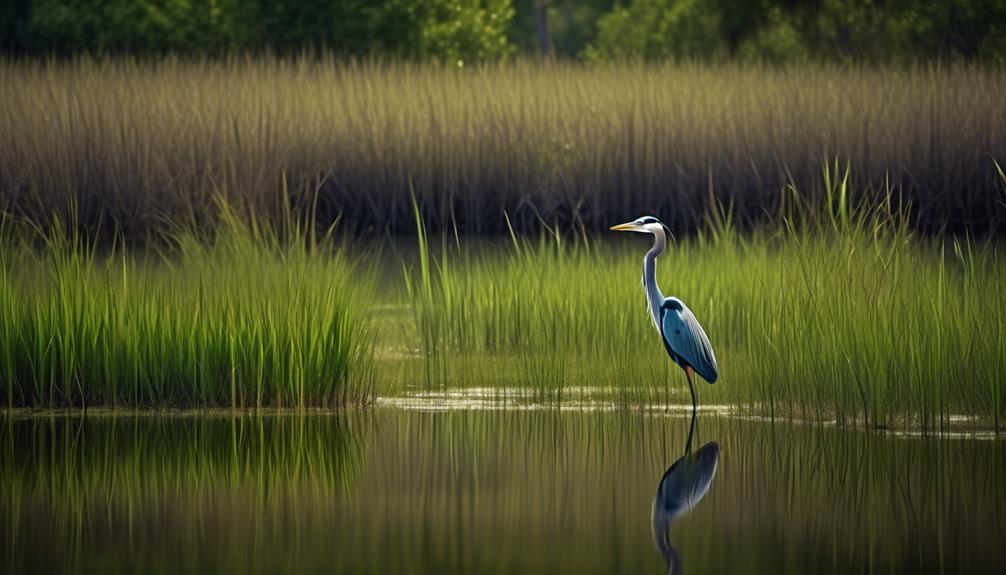As a nature enthusiast, I understand that some may argue that South Carolina is not known for its diverse bird species. However, I am here to challenge that notion and shed light on the remarkable big birds that call this state home.
From the majestic Bald Eagles soaring through the sky to the elegant Great Blue Herons gracefully wading in the marshes, South Carolina boasts an array of remarkable avian creatures.
But that's not all – there are also the graceful giants of the lakes, the American White Pelicans, the playful dancers of the coastline, the Reddish Egrets, and the ancient migrants of the plains, the Sandhill Cranes.
These big birds have captivating stories to tell, and their presence in South Carolina is truly something to behold.
Curious to discover more? Stay tuned as we take a closer look at these remarkable creatures.
Bald Eagles: Majestic Symbols of Freedom
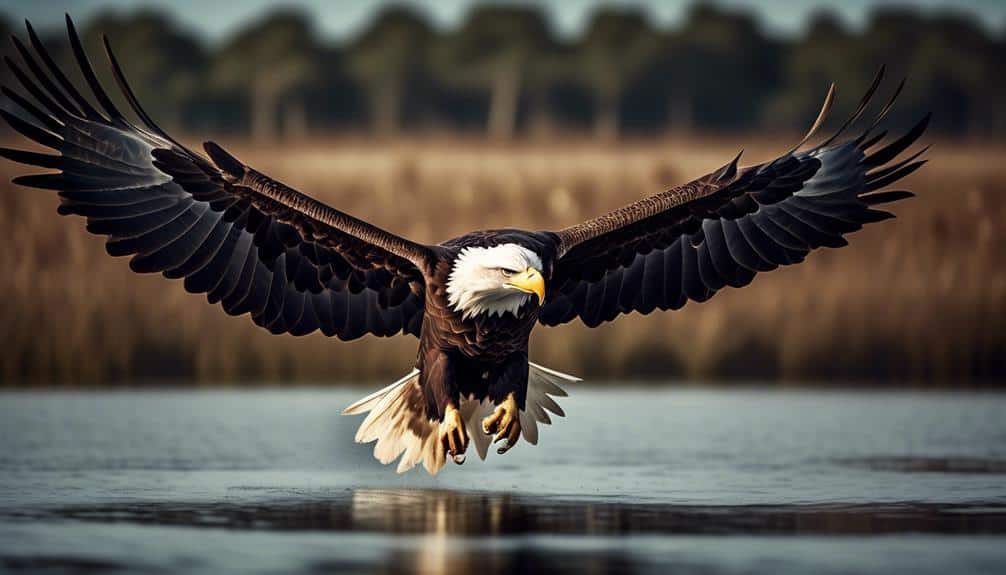
Bald eagles, the iconic raptors that grace the skies of South Carolina, are truly magnificent creatures, symbolizing the essence of freedom with their majestic presence. These birds of prey are known for their stunning appearance and powerful flight. With a wingspan of up to seven feet and a weight of up to 14 pounds, they're the largest birds in North America. Their striking white head and tail contrast beautifully with their dark brown body, making them instantly recognizable.
In terms of behavior, bald eagles are formidable hunters. They've sharp talons and a hooked beak that enable them to catch and tear apart their prey with precision. These birds primarily feed on fish, using their keen eyesight to spot their prey from high above in the sky. They're also known to scavenge for food, often stealing from other birds or taking advantage of roadkill.
Conservation efforts have played a vital role in the recovery of the bald eagle population in South Carolina. Due to habitat loss, pollution, and illegal hunting, their numbers declined drastically in the past. However, through the implementation of protective measures, such as the banning of harmful pesticides and the preservation of nesting sites, the bald eagle population has made a remarkable comeback. Today, they're no longer endangered, but they still require ongoing conservation efforts to ensure their continued survival.
Great Blue Herons: Elegant Waders of the Marshes
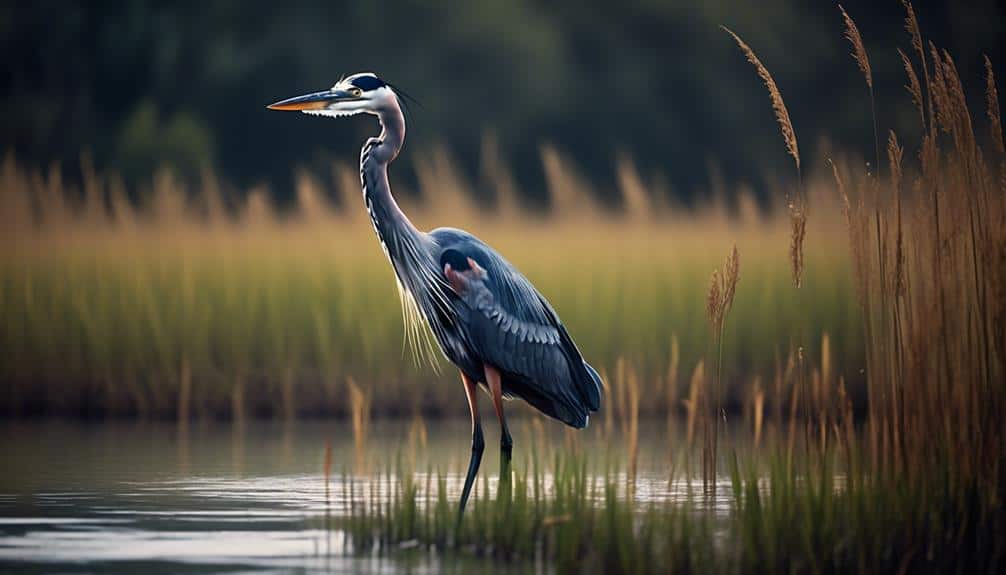
Great Blue Herons, graceful and majestic waders of the marshes, are a common sight in South Carolina's wetland habitats. These elegant herons, standing at an impressive height of 4 feet, are characterized by their long legs, dagger-like bills, and beautiful blue-gray plumage. They possess a wingspan of up to 6 feet, allowing them to soar gracefully through the skies.
Great Blue Herons are well-adapted to their marshy environments. Their long legs enable them to wade through shallow waters, while their sharp bills are perfectly designed for catching prey. These marsh waders primarily feed on small fish, amphibians, and crustaceans, using their stealth and patience to stalk their prey before striking with lightning speed.
During the breeding season, Great Blue Herons engage in elaborate courtship displays. Males perform intricate dances, flapping their wings and stretching their necks, while emitting a deep, guttural call to attract females. Once a pair has formed, they construct large stick nests in trees or on the ground near the water's edge. These nests, often shared by multiple generations, can reach sizes of up to 4 feet in diameter.
Great Blue Herons aren't only skilled hunters and nest builders but also play a vital role in the ecosystem. They help control fish populations and serve as indicators of wetland health. These elegant herons, with their striking appearance and important ecological role, truly exemplify the beauty and significance of South Carolina's marshes.
American White Pelicans: Graceful Giants of the Lakes
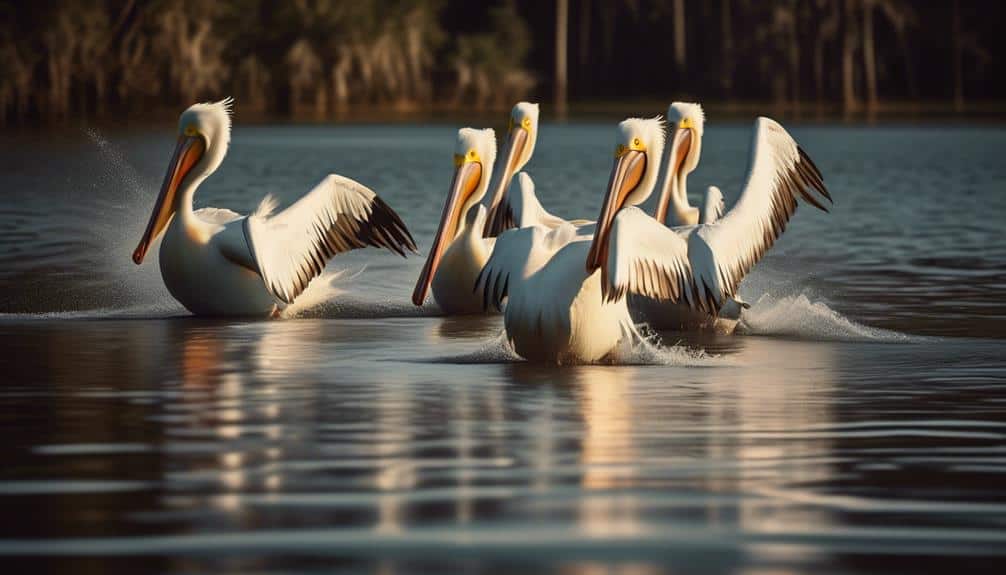
After marveling at the elegant waders of the marshes, it's time to turn our attention to the graceful giants of the lakes: the American White Pelicans. These magnificent birds are a sight to behold with their impressive size and stunning white plumage.
Here are four fascinating facts about American White Pelicans:
- Migration Patterns: American White Pelicans are known for their impressive migratory journeys. They breed in the northern regions of North America, including Canada and the northern United States, and then migrate south to warmer areas during the winter. Some pelicans can travel thousands of miles to reach their wintering grounds, which can include the Gulf Coast, Florida, and even Central and South America.
- Feeding Habits: American White Pelicans are highly skilled fishers. They use a unique feeding technique called 'cooperative fishing' where they work together to corral fish into shallow water before scooping them up in their large bills. These pelicans have a specialized pouch that can hold up to three gallons of water, allowing them to swallow large quantities of fish in one gulp.
- Diet: While fish make up the majority of their diet, American White Pelicans are opportunistic feeders and will also consume amphibians, crustaceans, and even small birds. They're known to gather in large groups, called colonies or pods, during feeding frenzies, making for a spectacular sight as they dive and glide across the water surface.
- Conservation Status: American White Pelicans are currently listed as a species of least concern by the International Union for Conservation of Nature (IUCN). However, they face threats such as habitat loss, disturbance at breeding sites, and pollution. Efforts to protect their breeding and wintering grounds, as well as conservation initiatives to ensure their food resources remain abundant, are crucial for the long-term survival of these magnificent birds.
Reddish Egrets: Playful Dancers of the Coastline
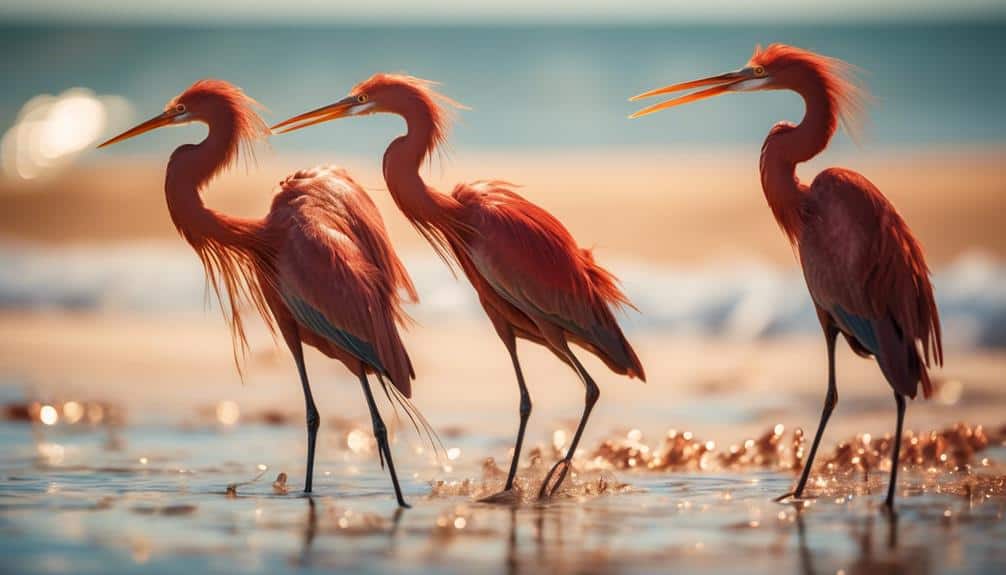
Reddish Egrets, known for their playful and captivating displays, are a mesmerizing sight along the coastlines of South Carolina. These elegant birds are characterized by their unique feeding habits and their playful behavior during hunting.
Reddish Egrets primarily feed on small fish, crustaceans, and amphibians found in shallow coastal waters. They've a distinctive hunting technique known as 'canopy feeding', where they spread their wings to create shade and reduce glare on the water's surface, making it easier to spot their prey.
During feeding, Reddish Egrets display their playful side by engaging in a range of amusing behaviors. They often dance around in shallow water, flapping their wings and spinning in circles. This behavior isn't just for entertainment; it serves a purpose in their hunting strategy. The dancing motion helps to stir up prey and disorient them, making them easier to catch. It also attracts the attention of other nearby birds, causing them to scatter and reveal hidden prey.
Reddish Egrets are also known for their acrobatic fishing techniques. They can be seen running, jumping, and even somersaulting in pursuit of their prey. This playful behavior not only showcases their agility but also increases their chances of success in catching food.
Sandhill Cranes: Ancient Migrants of the Plains
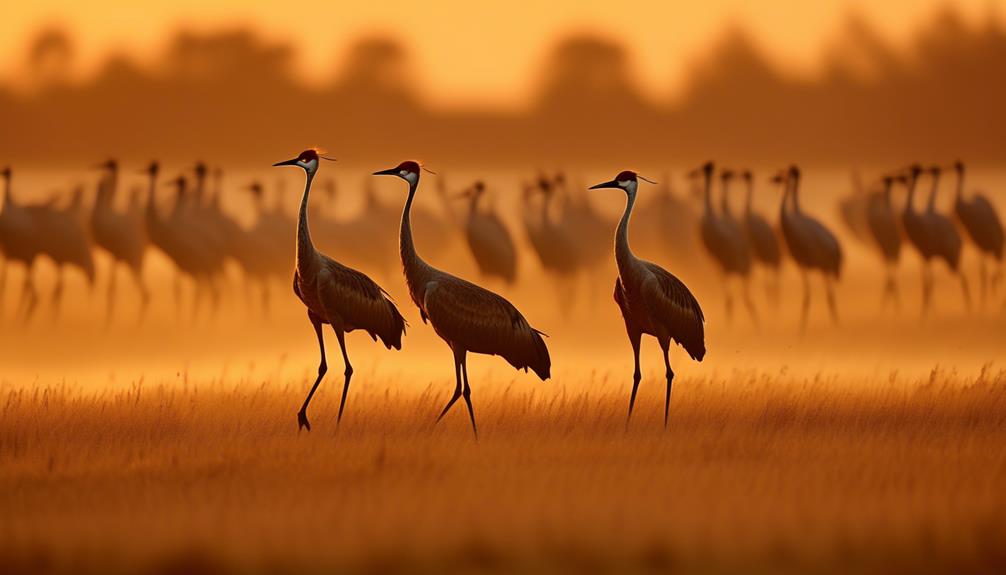
Continuing our exploration of the diverse bird species in South Carolina, let's now turn our attention to the remarkable Sandhill Cranes, ancient migrants of the plains. These magnificent birds have a fascinating history and are known for their impressive migration patterns.
- Impressive Migrations: Sandhill Cranes are known for their long-distance migrations, covering thousands of miles each year. They breed in the northern parts of North America and then travel south during the winter months to warmer regions such as South Carolina.
- Distinctive Appearance: These large birds are easily recognizable with their long legs, grayish-brown feathers, and distinctive red crowns. They stand about four feet tall and have a wingspan of up to seven feet, making them an impressive sight in flight.
- Population Decline: Unfortunately, Sandhill Cranes have experienced a decline in population due to habitat loss, hunting, and changes in agricultural practices. Efforts are being made to protect their habitats and raise awareness about the importance of conservation.
- Conservation Efforts: Organizations such as the South Carolina Department of Natural Resources are working to protect and restore suitable habitats for Sandhill Cranes. Additionally, educational programs aim to raise awareness among the public about the importance of preserving these ancient migrants.
As we continue to appreciate the diverse bird species in South Carolina, it's crucial that we take action to ensure the survival of these majestic Sandhill Cranes and their remarkable migration patterns.
Frequently Asked Questions
How Long Do Bald Eagles Typically Live?
Bald eagles typically live for about 20 to 30 years in the wild. However, with bald eagle conservation efforts and the lifespan of other bird species taken into account, some bald eagles have been known to live up to 40 years or more.
What Is the Average Wingspan of a Great Blue Heron?
The average wingspan of a great blue heron is approximately 6 feet. These majestic birds can be found in various habitats, including wetlands and coastal areas. Conservation efforts are crucial to protect their populations and ensure their continued survival.
How Many American White Pelicans Are Estimated to Migrate to South Carolina Each Year?
Each year, thousands of American white pelicans migrate to South Carolina, making it a vital stopover for these majestic birds. Conservation efforts have been crucial in preserving their habitat and ensuring their continued presence in the state.
What Is the Diet of Reddish Egrets?
The diet of reddish egrets consists mainly of small fish, crustaceans, and amphibians. They are skilled hunters, using their long legs and quick movements to catch prey in shallow water. Reddish egrets prefer coastal habitats, such as saltmarshes and mangrove swamps, for feeding.
How Far Do Sandhill Cranes Usually Migrate During Their Annual Migration?
Sandhill cranes usually migrate long distances during their annual migration. Their migration patterns can vary, but they typically travel thousands of miles to reach their wintering grounds. These big birds have interesting nesting habits as well.
Conclusion
In conclusion, the diverse bird species found in South Carolina are truly remarkable.
From the majestic Bald Eagles soaring through the skies to the elegant Great Blue Herons gracefully wading in the marshes, each bird offers a unique contribution to the ecosystem.
For instance, the American White Pelicans, with their impressive wingspan, play a crucial role in maintaining the balance of the lakes by consuming large quantities of fish.
These birds are a testament to the beauty and importance of nature's intricate web of life.

